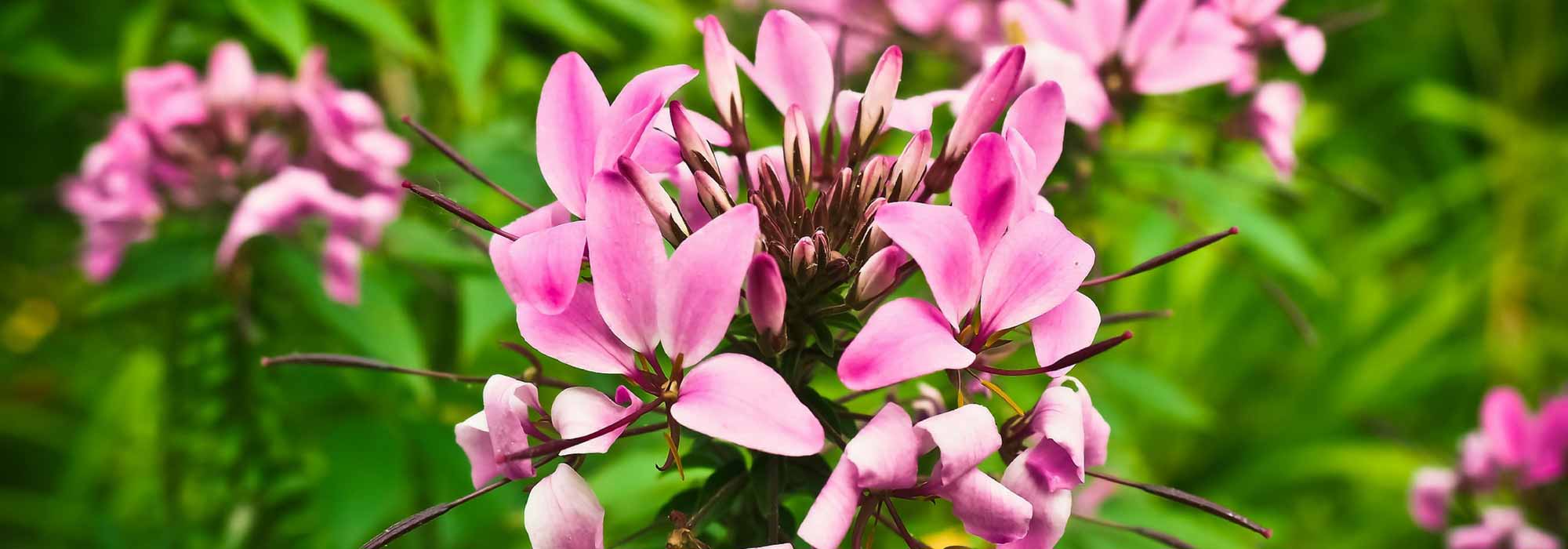
Cleome, spider flower: sowing, planting, cultivation
Contents
Cleome in a nutshell
- Cleome is one of the most graceful annual flowers
- Its original flowering lasts all summer
- Fast-growing, it adds volume and colour in one season
- It loves sun, warmth, and having its feet cool
- It is perfect in romantic pots and for bringing lightness to borders
A word from our expert
The Cleome or “Spider Flower”, also known as Cleome spinosa or Cleome Rose, is a tall annual plant that offers a long, graceful flowering period, with long stamens giving it a unique appearance. Not a perennial, Cleome is the star of the borders with its ephemeral charm, needing to be replanted each year for a dynamic and evolving garden.
Terribly refined, its white, pink, purple, or rosy-red flowers, crowned with prominent stamens, bloom all summer long in the borders, from June to early autumn without interruption.
With its tall and singular silhouette, delicate hues, and exuberant foliage, it is essential in summer compositions inspired by romantic, exotic, or wilder themes.

From Cleome spinosa, also known as spiny Cleome (or Cleome hassleriana), to the white Cleome or the ‘Senorita Rosalita’ Cleome with its beautiful lavender-pink clusters, Cleome is indispensable for adding height and lightness to the borders.
Cleome is one of the most effective annuals for creating a floriferous border at the edge of a shrub border, a background that is both dense and airy, or a romantic pot.
This tropical annual will thrive if planted in full sun in fertile, loose, cool, and well-drained soil.
Quickly discover our Cleome plug plants or our collection of Cleome seeds, this easy annual that will delight busy beginner gardeners!
Description and Botany
Botanical data
- Latin name Cleome, Cleome pungens, syn. Cleome spinosa, syn. Cleome hassleriana
- Family Capparaceae
- Common name cleome, spider flower, spider plant
- Flowering from June until autumn
- Height 0.60 to 1.50 m
- Exposure Sun
- Soil type All, well-drained
- Hardiness not hardy
The Cleome, also known as “spider flower”, is a plant native to the sandy plains and valleys of tropical South America. Not very hardy, it is grown as an annual in our climates as it cannot withstand frost and does not survive temperatures below 6-8°C. Like its cousin the caper, it belongs to the family Capparaceae, and it can be found naturalised in other parts of the world, in fallow land and on low-altitude slopes.
The genus comprises around 150 species, but only the type species, Cleome spinosa, also known as spiny cleome (syn. Cleome pungens, C. hassleriana), from which many varieties are derived, is cultivated in our latitudes.
With a rapid growth rate, cleome quickly forms a beautiful tuft with an upright, bushy, and dense habit, reaching over 1 m in height and spreading up to 45 cm wide.
On tall, branched, hairy to spiny stems that are slightly sticky, large palmate leaves measuring 10 to 12 cm long with crenate margins unfold. Supported by long spiny petioles at their base, they are divided into 3 to 7 velvety, ovate to lanceolate leaflets, ending in a long pointed tip. Some cultivars are thornless. This delicate, deciduous foliage, bright green to dark green, disappears in the off-season.
On this lush vegetation, both compact yet very light, astonishing inflorescences, remarkable for their architecture and lightness, appear. Abundant and delicate, they renew from June until frost.
Grouped in fluffy terminal bouquets, the flowers surprise with their sophisticated structure.
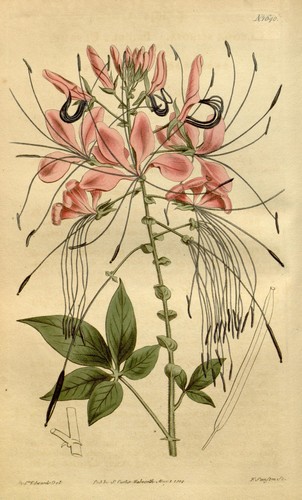
Cleome – botanical illustration
Each flower opens into four fine petals from which very long protruding stamens, slender and elongated, escape, extending well beyond the corolla. These prominent filaments give the plant a tousled and refined appearance reminiscent of mustard flowers.
With this particularly long arachnid-like flowering, cleome ranks among the most beautiful annual flowers. Numerous, they measure 1 to 10 cm in diameter. Their colour varies, depending on the species, from pure white to pink, lilac, and purple. Some cultivars, such as Cleome spinosa ‘Sparkler Blush’, bear bicoloured light pink and white flowers.
The delicate, tousled inflorescences make for very pretty cut flowers in summer bouquets.
The inflorescences give way one after the other to equally original fruits. Long, hairy green pods, measuring 6 to 12 cm in length, hang from the petioles, developing beneath the flowers from the base of the spike. By autumn, flowers and fruits often coexist. Some hybrids are sterile and produce neither siliques nor seeds!
These pods contain numerous seeds, turning dark brown to black as they dry; elongated and thin, they resemble spider legs, which has earned cleome the nickname “spider plant” or “spider flower.”
Cleome enjoys a sunny exposure and protection from strong winds that could bend its stems. It prefers rich, light, always moist, and well-drained soils.
With its tall, graceful stems and light flowering, Cleome brings breath, movement, and height to the garden. Versatile, it is ideal for creating romantic pots, adding a touch of lightness and relief in borders and mixed beds.

Main species and varieties
The type species Cleome pungens or Spiny Cleome has several synonyms (syn. C. spinosa, C. hassleriana), and although they refer to the same species, it is available in interesting hybrids and cultivars such as ‘Colour Fountain’ and those from the ‘Queen’ group, sold here in seed packets or as plug plants. While most have thorny stems, ‘Senorita Rosalita’ is a cultivar that is thornless.
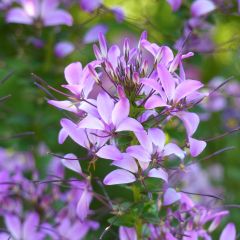
Cleome Señorita Rosalita
- Flowering time August to October
- Height at maturity 70 cm
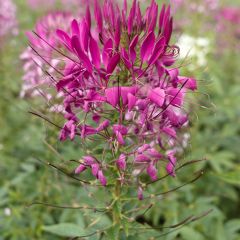
Cleome spinosa Violet Queen Seeds - Spider Plant
- Flowering time July to November
- Height at maturity 1 m
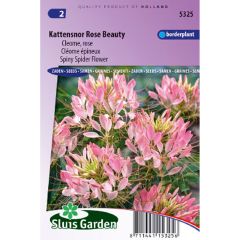
Cleome spinosa Rose Beauty Seeds - Spider plant
- Flowering time July to November
- Height at maturity 1 m
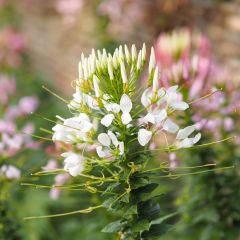
Cleome spinosa White Queen Seeds - Spider plant
- Flowering time July to November
- Height at maturity 1 m
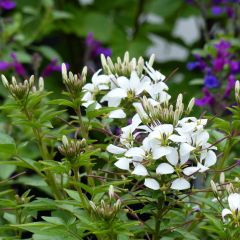
Cleome Señorita Blanca
- Flowering time August to November
- Height at maturity 80 cm
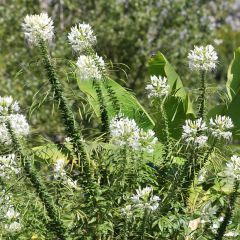
Thorny seeds of Helen Campbell Spiky - Cleome spinosa
- Flowering time July to November
- Height at maturity 1,20 m
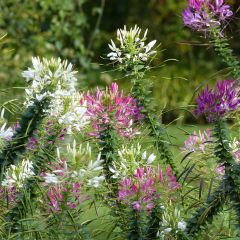
Cleome spinosa Colour Fountain Mix Seeds - Spider plant
- Flowering time July to November
- Height at maturity 1 m
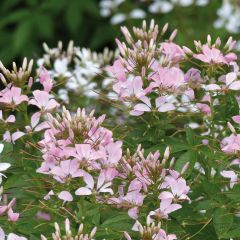
Cleome Señorita Carolina
- Flowering time June to November
- Height at maturity 60 cm
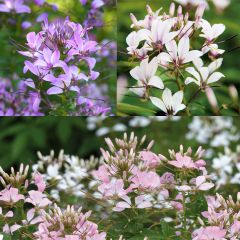
Collection of 3 Senorita Cleomes
- Flowering time July to November
Discover other Cleome
View all →Available in 0 sizes
Available in 2 sizes
Available in 1 sizes
Available in 1 sizes
Available in 1 sizes
Available in 1 sizes
Available in 1 sizes
Available in 1 sizes
Available in 1 sizes
Available in 1 sizes
Planting Spider Flowers
Where to plant Cleome?
If this annual prefers sun and warmth, it also acclimatises in less clement regions, as it appreciates soils that remain cool during the summer months. Frost-sensitive, it dies quickly once temperatures drop below 2°C, which is why in our gardens, it is grown as an annual.
Cleome thrives in full sun and sheltered from the wind: if you want to avoid unsightly staking, it is better to give it a spot protected from strong winds that could cause the stems to bend.
It requires rich, light, sandy, and well-drained soil.
Cleome creates a lush, flowering bush throughout the summer. It is the annual to use at the back or centre of flower beds to add volume in a single season.
To prevent its flower spikes from collapsing in the middle of the bed, it is advisable to plant the tallest varieties alongside other plants and bushes that they can lean on.
Planted in series, it will also flower a sunny pathway border or delineate a vegetable patch or a fruit square. It can also be grown in abundant rows of cut flowers. It also makes beautiful romantic planters.
When to plant Cleome?
The planting of Cleome in plugs takes place in spring in April or May, as soon as the first rays of sun begin to warm the soil.
Upon receipt, transplant and store our young plants in plug plants under cover (veranda, greenhouse, cold frame…) at a temperature above 14°C for a few weeks before installing them in the garden as soon as the risk of frost has passed.
Sow Cleome seeds from mid-January to mid-March, keep warm and wait for the frosts to be over, in May, to transplant the young plants directly into the ground.

How to plant Cleomes?
- In the ground
For a beautiful effect, favour group planting or with other tall summer flowers. Count 4-5 plugs per m², given the strong growth of this annual, this is sufficient to create a lovely effect. Space the plants 40 cm apart. The soil should be light, loose, and humus-bearing. Be sure to add potting soil and gravel in soil where water tends to stagnate. Some varieties may require staking.
- Loosen the soil well
- Amend with a good dose of well-decomposed compost
- Position the plug and fill the hole
- Firmly pack without damaging the plant
- Mulch once the plants have reached about 30 cm high to keep the soil cool during summer, this guarantees prolonged flowering
- Water and then water again in dry weather
- Cleome in pots
The substrate must be very draining to avoid stagnant moisture. Place it in full sun in a large pot of at least 30 cm in diameter. You may need to stake the stems.
- Spread a good layer of drainage (gravel or clay balls)
- Plant in a mixture of sandy soil mixed with compost
- Mulch the base
- Water regularly, never allowing the substrate to dry out between waterings
How to sow Cleome?
In trays
Cleome seeds are sown early under frost-free shelter, from February to mid-March.
- Sow Cleome seeds in trays in a light potting mix
- Barely cover the seeds
- Place the seedlings in a warm spot (minimum 20°C) and in the light
- Keep moist until the seedlings emerge
- Transplant into individual buckets when the seedlings are about 3 cm tall
- Transplant outdoors in May once all risk of frost has passed
Direct sowing in open ground
In well-prepared soil (add a mix of 80% potting mix and 20% sand) and amended, sow directly in place in May, when there is no more frost. Push the seeds 1 cm deep, then cover them with potting mix. Lightly firm down and water to keep the soil moist until emergence, which takes between 12 days and 1 month if temperatures do not warm up quickly. Thin the seedlings to give the young Cleomes space to develop properly.
→ Learn more about the sowing of Cleome in our tutorial!
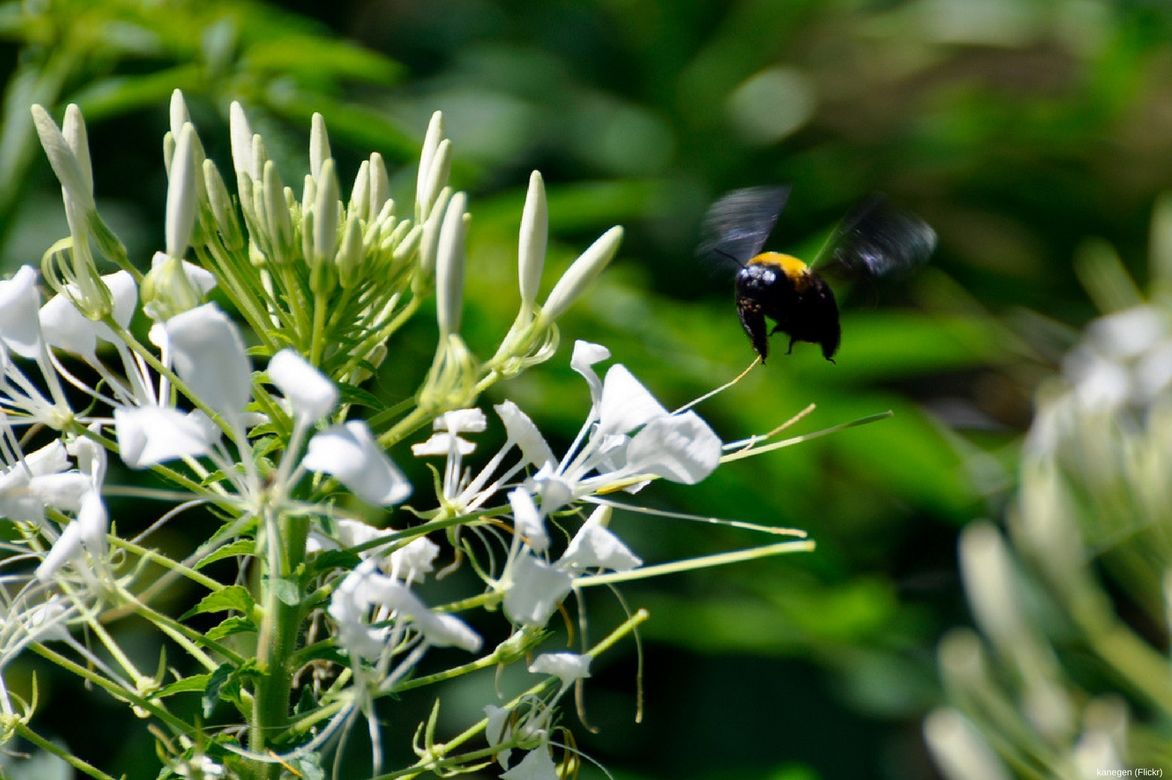
Maintenance and care
The Cleome requires almost no maintenance: just ensure that the substrate never dries out.
Water very regularly, and twice a week during hot weather, at the base of the plant and not on the foliage. Mulch with a layer of 2 cm of dry straw or turf to maintain moisture throughout the summer. Optionally, apply liquid fertiliser once a month.
Support the stems of tall cleomes if necessary as the plant grows. Remove faded flowers to encourage the appearance of new flowers and extend the flowering period. Pull up the plant when it starts to wither with the arrival of the first frosts. Don’t forget to wear gloves when handling it as its thorns are as discreet as they are prickly!
Diseases and potential pests
The cleome is neither prone to diseases nor to attacks from parasitic pests. It may occasionally be sensitive to powdery mildew: apply nettle manure sprays.
Multiplication
Cleome can be propagated by cuttings, but sowing remains the simplest method; it even tends to self-seed! Sowing takes place at the end of winter, in trays under a heated frame or in a greenhouse as early as possible in spring, using well-ripened seeds harvested between mid-August and the end of September as soon as they turn dark brown, before they fall, or with seeds purchased in packets.
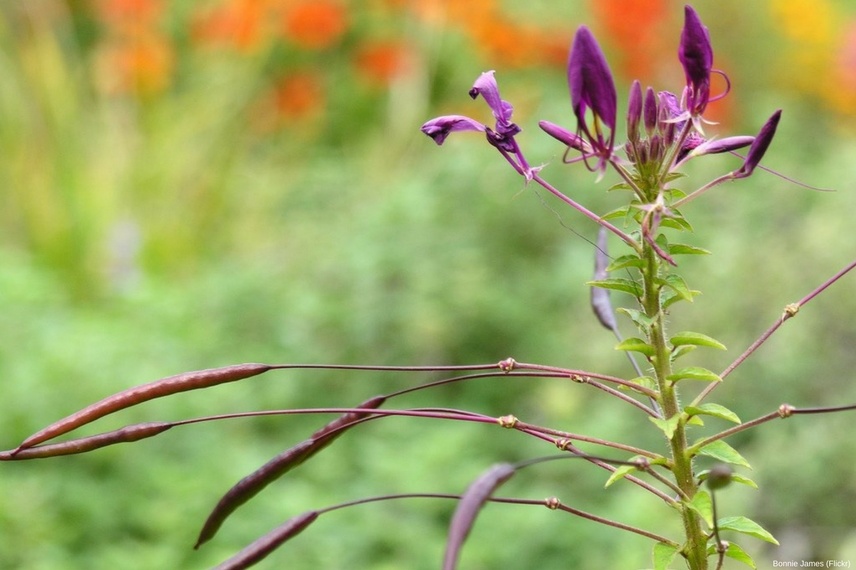
Cleome pods contain many seeds.
Associate
Versatile, Cleome blooms all summer in naturalistic beds, path borders, and mixed borders in the English style. With its long, graceful stems, it is essential in romantic or wild-inspired displays.

An idea for pairing in a natural bed: flowers of Cleome spinosa ‘Cherry Queen’ accompanied by Amaranths with large upright inflorescences like Amaranthus ‘Fat Spike’.
Planted in numbers rather than alone, it adds height, thickness, and a lot of lightness to a bed in a contrasting version or in a harmony of pastel tones.
Cleomes are ideally matched in height with Buenos Aires Verbenas, cosmos, Oriental Poppies, and other tall summer flowers with which they create beautiful contrasts of floral shapes.
In a lush summer bed, place them towards the back with a mix of perennials and annuals like freesias, dahlias, or gauras.
The tallest varieties may require staking, which can be advantageously replaced by positioning them well sheltered from the wind, in front of ramified bushes: they will be the perfect companions for late-flowering roses such as China roses and musk hybrids, at the feet of which they will create exquisite late summer scenes while ensuring a refined foreground.
The flowers of Cleome, with their great lightness, pair well with grasses like pennisetums or large cultivars of Miscanthus.
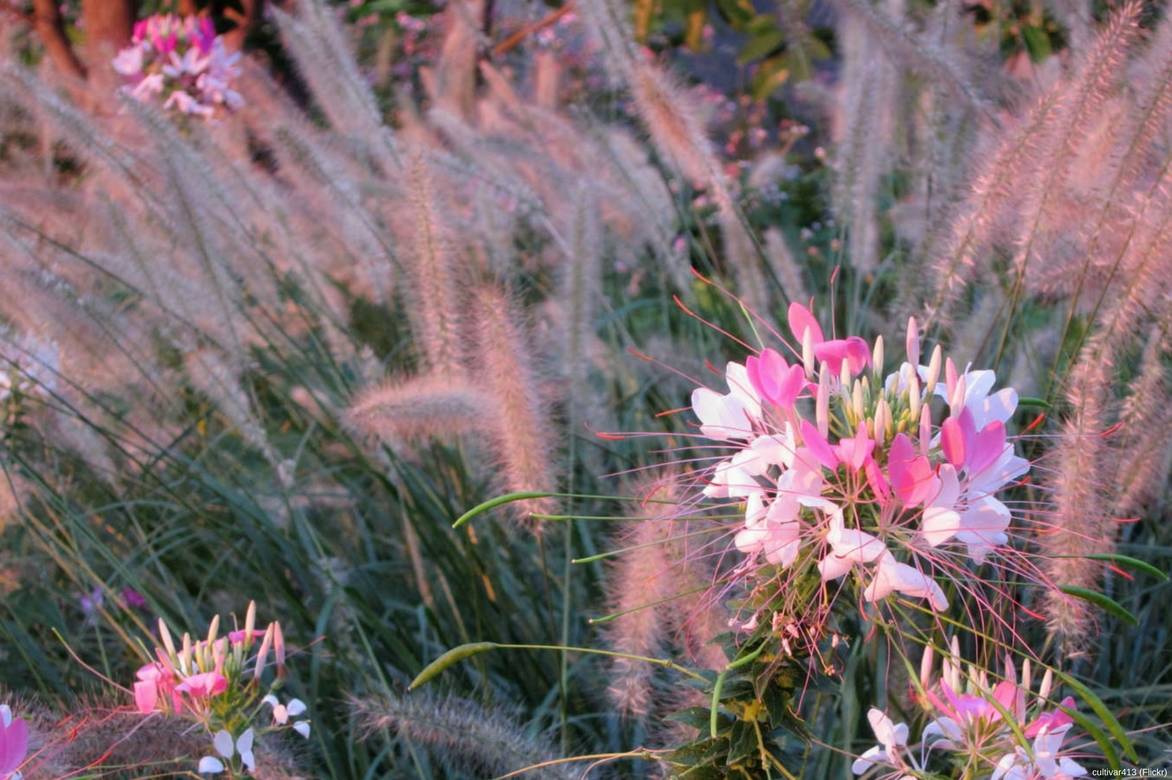
A light pairing idea: Cleome hassleriana (also a lovely scene with the delightful white flowers of Cleome hassleriana ‘Helen Campbell’) and Pennisetum alopecuroides ‘Herbstzauber’.
For beautiful exotic or romantic pots, pair it with tibouchinas or clarkias.
→ Discover more pairing ideas with Cleome in our advice sheet!
Useful resources
- The world of annuals is endless, discover those you can pair with cleome!
- Sowing cleomes has never been easier with our cleome seeds
- Our advice sheet: 5 pink-flowered cleomes to have in your garden
- Subscribe!
- Contents


































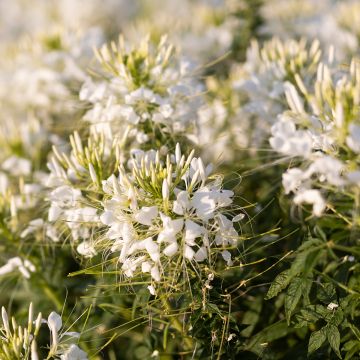
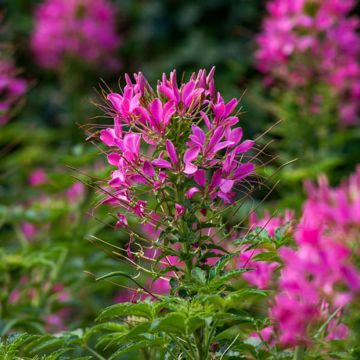

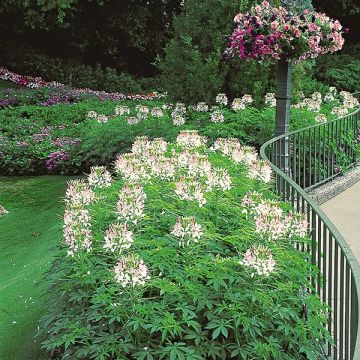

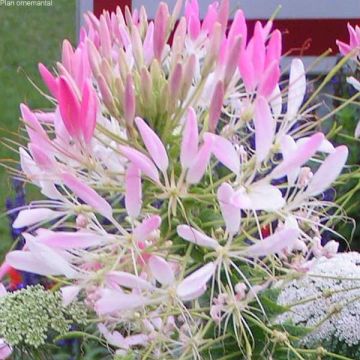

Comments